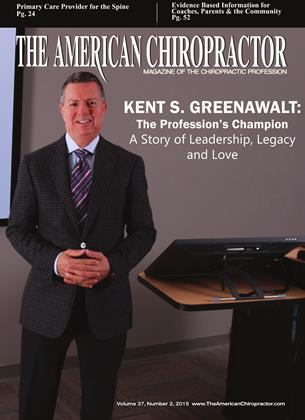Safety and Effectiveness: The Foundations of Success
PERSPECTIVE
Arlan Fuhr
EVERY CHIROPRACTOR SHOULD CONSIDER TWO IMPORTANT QUESTIONS, NO MATTER WHAT STAGE OF HIS OR HER CAREER. FIRST, HOW SAFE AND EFFECTIVE IS THE ADJUSTING INSTRUMENT YOU ARE USING? SECOND, IS THE METHOD YOU ARE USING TO FIND A SUBLUXATION VALIDATED BY RESEARCH?
These two questions go straight to the heart of our integrity as a profession and are critical to building, preserving, and maintaining your own practice and reputation.
Activator recently experienced the power of these questions firsthand as we sought and received approval for the use of Activator instruments in Australia. Licensure of adjusting instruments in that country is handled by the Therapeutic Goods Administration (TGA), and among their very first requests of us was for data that would show the safety and effectiveness of the Activator.
I’ve often said that research will save the day, and that maxim has proven to be true once again. Activator forwarded a 1985 paper, funded by the US National Institutes of Health (NIH), to the TGA that answered these specific queries. Activator passed
(Another recent newsletter, The Chiropractic Report by the Secretary General of the World Federation of Chiropractic, gives some history of the Activator Method, as well as an overview of the collected research. Read the report here: https://chiropracticreport. com/index.php/current-issue. )
Here in the US and around the world, Activator bases its success on research. We recently published our eighteenth clinical trial (read an assortment of Activator research by visiting our website at http://www.activator.com/research/). To our knowledge, no other adjusting instrument on the market today—besides the Activator—has any clinical trials supporting effectiveness. (It is worth noting that a study about a specific instrument does not automatically apply to all other instruments. That would be something like publishing a study about a particular drug, and then attempting to use it to make claims about similar drags that were never tested. Once again, my advice is to put your faith in solid research.)
Another question posed frequently is whether research validates techniques for locating a subluxation with specific testing. The paper titled “Review of Methods Used by Chiropractors to Determine the Site for Applying Manipulation” by Triano et al. in Chiropractic and Manual Therapies 2013, 21:36 (http:// www.chiromt.com/content/21/1/36) is a comprehensive evaluation of how chiropractors assess a patient and know where to manipulate. You will be quite surprised to see what the evidence does support, as well as what it does not support.
As chiropractors, we have a tendency to ran from one new piece of equipment to another, sometimes spending a great deal of money without asking these simple questions. I hope these musings convince the veteran field practitioner as well as the new student to make informed decisions about the adjusting instruments and methods of analysis they will use to determine safety and effectiveness for their own patients.
Dr. Ariern Fuhr travels extensively to chiropractic seminars, conferences and events around the world. He will be providing his insights and perspectives from these visits as a regular guest commentator for Die American Chiropractor You can reach him at 602-445-4230 or email [email protected].
 View Full Issue
View Full Issue






